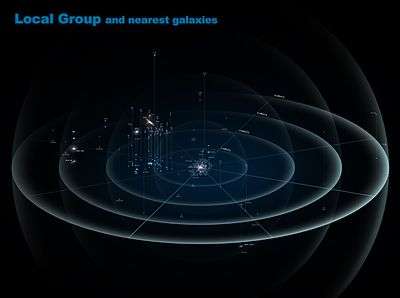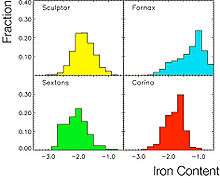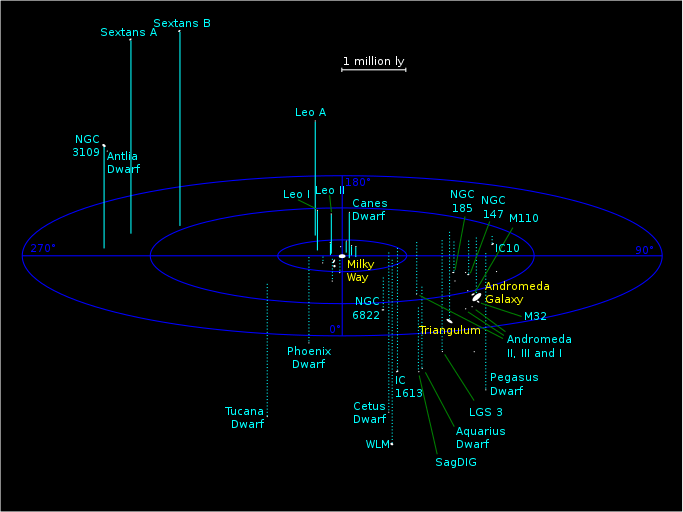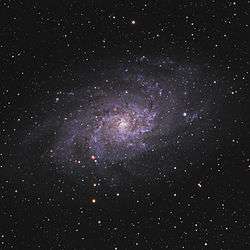Local Group
The Local Group is the galaxy group that includes the Milky Way. It has a total diameter of roughly 3 megaparsecs (9.8 Mly), and a total mass of the order of 2×1012 solar masses (4.0×1042 kg).[1] It consists of two clusters of galaxies in a "dumbbell" shape: the Milky Way and its satellites form one lobe, and the Andromeda Galaxy and its satellites constitute the other. The two clusters are separated by about 0.8 Mpc (2.5×1022 m) and move towards one another with a velocity of 123 km/s.[2] The group itself is a part of the larger Virgo Supercluster, which may be a part of the Laniakea Supercluster. The total number of galaxies in the Local Group is unknown as some are occluded by the Milky Way; however, at least 80 such objects are known (most of which are dwarf galaxies).


The two largest members, the Andromeda Galaxy and the Milky Way, are both spiral galaxies with masses of about 1012 solar masses each, and each have their own system of satellite galaxies:
- The Andromeda Galaxy's satellite system consists of Messier 32 (M32), Messier 110 (M110), NGC 147, NGC 185, Andromeda I (And I), And II, And III, And V, And VI (also known as Pegasus Dwarf Spheroidal Galaxy, or Pegasus DSph), And VII (also known as Cassiopeia Dwarf Galaxy), And VIII, And IX, And X, And XI, And XIX, And XXI and And XXII, plus several additional ultra-faint dwarf spheroidal galaxies.[3]
- The Milky Way's satellite galaxies system comprises Sagittarius Dwarf Galaxy, Large Magellanic Cloud, Small Magellanic Cloud, Canis Major Dwarf Galaxy (disputed, considered by some not a galaxy), Ursa Minor Dwarf Galaxy, Draco Dwarf Galaxy, Carina Dwarf Galaxy, Sextans Dwarf Galaxy, Sculptor Dwarf Galaxy, Fornax Dwarf Galaxy, Leo I (a dwarf galaxy), Leo II (a dwarf galaxy), and Ursa Major I Dwarf Galaxy and Ursa Major II Dwarf Galaxy, plus several additional ultra-faint dwarf spheroidal galaxies.[4]
The Triangulum Galaxy is the third-largest member of the Local Group, with a mass of approximately 5×1010 M☉, and is the third spiral galaxy.[5] It is unclear whether the Triangulum Galaxy is a companion of the Andromeda Galaxy, although the two galaxies experienced a close passage 2–4 billion years ago which triggered star formation across Andromeda's disk. The Pisces Dwarf Galaxy is equidistant from the Andromeda Galaxy and the Triangulum Galaxy, so it may be a satellite of either.[6]
The membership of NGC 3109, with its companions Sextans A and the Antlia Dwarf Galaxy, is uncertain due to extreme distances from the center of the Local Group.[2] The other members of the group are likely gravitationally secluded from these large subgroups: IC 10, IC 1613, Phoenix Dwarf Galaxy, Leo A, Tucana Dwarf Galaxy, Cetus Dwarf Galaxy, Pegasus Dwarf Irregular Galaxy, Wolf–Lundmark–Melotte, Aquarius Dwarf Galaxy, and Sagittarius Dwarf Irregular Galaxy.[7]
History
The term "The Local Group" was introduced by Edwin Hubble in Chapter VI of his 1936 book The Realm of the Nebulae.[8] There, he described it as "a typical small group of nebulae which is isolated in the general field" and delineated, by decreasing luminosity, its members to be M31, Milky Way, M33, Large Magellanic Cloud, Small Magellanic Cloud, M32, NGC 205, NGC 6822, NGC 185, IC 1613 and NGC 147. He also identified IC 10 as a possible part of the Local Group.
By 2003, the number of known Local Group members had increased from his initial 12 to 36.[9]
Component galaxies
Map


List of galactic bodies
| Spiral galaxies | |||
|---|---|---|---|
| name | type | constellation | notes |
| Andromeda Galaxy (M31, NGC 224) | SA(s)b | Andromeda | Largest galaxy in the group,[10]
at about 125% of the mass of the Milky Way.[2] Diameter: 220 kly, mass: (1.15±0.35)×1012 M☉, number of stars: ca. 1012. |
| Milky Way | SBbc | Sagittarius (centre) |
Diameter: 175±25 kly, mass: (1.3±0.3)×1012 M☉, number of stars: (2.5±1.5)×1011.[11] |
| Triangulum Galaxy (M33, NGC 598) | SA(s)cd | Triangulum | Third largest, only unbarred spiral galaxy and possible satellite of the Andromeda Galaxy.
Diameter: 60 kly, mass: 5×1010 M☉, number of stars: 4×1010. |
| Elliptical galaxies | |||
| name | type | constellation | notes |
| M32 (NGC 221) | E2 | Andromeda | Satellite of the Andromeda Galaxy |
| Irregular galaxies | |||
| name | type | constellation | notes |
| Wolf–Lundmark–Melotte (WLM, DDO 221) | Ir+ | Cetus | |
| IC 10 | KBm or Ir+ | Cassiopeia | |
| Small Magellanic Cloud (SMC, NGC 292) | SB(s)m pec | Tucana | Satellite of Milky Way, 6th largest galaxy in the local group with mass of between 7.5 and 8 billion solar mass. |
| Canis Major Dwarf | Irr | Canis Major | Satellite of Milky Way |
| Pisces Dwarf (LGS3) | Irr | Pisces | Possible satellite of the Triangulum Galaxy |
| IC 1613 (UGC 668) | IAB(s)m V | Cetus | |
| Phoenix Dwarf | Irr | Phoenix | |
| Large Magellanic Cloud (LMC) | Irr/SB(s)m | Dorado | Fourth largest member of the group, satellite of Milky Way, mass between 10 and 85 billion solar masses. Recent finding puts it at 10% mass of Milky Way Galaxy.[12] |
| Leo A (Leo III) | IBm V | Leo | |
| Aquarius Dwarf (DDO 210) | IB(s)m | Aquarius | Distance 3.2 million light years. Quite isolated in space, membership to Local Group established in 1999.[13] |
| Dwarf elliptical galaxies | |||
| name | type | constellation | notes |
| M110 (NGC 205) | dE6p | Andromeda | Satellite of the Andromeda Galaxy and 5th largest galaxy with the mass of 9.3 billion solar masses. |
| NGC 147 (DDO 3) | dE5 pec | Cassiopeia | Satellite of the Andromeda Galaxy |
| SagDIG (Sagittarius Dwarf Irregular Galaxy) | IB(s)m V | Sagittarius | Most remote from barycenter member thought to be in the Local Group.[13] |
| NGC 6822 (Barnard's Galaxy) | IB(s)m IV-V | Sagittarius | |
| Pegasus Dwarf (Pegasus Dwarf Irregular, DDO 216) | Irr | Pegasus | |
| Dwarf spheroidal galaxies | |||
| name | type | constellation | notes |
| Boötes I | dSph | Boötes | |
| Cetus Dwarf | dSph/E4 | Cetus | |
| Canes Venatici I Dwarf and Canes Venatici II Dwarf | dSph | Canes Venatici | |
| KKs 3 | dSph | ||
| Andromeda III | dE2 | Andromeda | Satellite of the Andromeda Galaxy |
| NGC 185 | dE3 pec | Cassiopeia | Satellite of the Andromeda Galaxy |
| Andromeda I | dE3 pec | Andromeda | Satellite of the Andromeda Galaxy |
| Sculptor Dwarf (E351-G30) | dE3 | Sculptor | Satellite of Milky Way |
| Andromeda V | dSph | Andromeda | Satellite of the Andromeda Galaxy |
| Andromeda II | dE0 | Andromeda | Satellite of the Andromeda Galaxy |
| Fornax Dwarf (E356-G04) | dSph/E2 | Fornax | Satellite of Milky Way |
| Carina Dwarf (E206-G220) | dE3 | Carina | Satellite of Milky Way |
| Leo I (DDO 74) | dE3 | Leo | Satellite of Milky Way |
| Sextans Dwarf | dE3 | Sextans | Satellite of Milky Way |
| Leo II (Leo B) | dE0 pec | Leo | Satellite of Milky Way |
| Ursa Minor Dwarf | dE4 | Ursa Minor | Satellite of Milky Way |
| Draco Dwarf (DDO 208) | dE0 pec | Draco | Satellite of Milky Way |
| SagDSG (Sagittarius Dwarf Spheroidal Galaxy) | dSph/E7 | Sagittarius | Satellite of Milky Way |
| Tucana Dwarf | dE5 | Tucana | |
| Cassiopeia Dwarf (Andromeda VII) | dSph | Cassiopeia | Satellite of the Andromeda Galaxy |
| Pegasus Dwarf Spheroidal Galaxy (Andromeda VI) | dSph | Pegasus | Satellite of the Andromeda Galaxy |
| Ursa Major I Dwarf and Ursa Major II Dwarf | dSph | Ursa Major | Satellite of Milky Way |
| Leo IV | dSph | Leo | Satellite of the Milky Way |
| Leo V | dSph | Leo | Satellite of the Milky Way |
| Leo T | dSph/Irr | Leo | Satellite of the Milky Way |
| Boötes II | dSph | Boötes | Satellite of the Milky Way |
| Boötes III | dSph | Boötes | Satellite of the Milky Way |
| Coma Berenices | dSph | Coma Berenices | Satellite of the Milky Way |
| Segue 2 | dSph | Aries | Satellite of the Milky Way |
| Hercules | dSph | Hercules | Satellite of the Milky Way |
| Pisces II | dSph | Pisces | Satellite of the Milky Way |
| Reticulum II | dSph | Reticulum | Satellite of the Milky Way |
| Eridanus II | dSph | Eridanus | Probable satellite of the Milky Way |
| Grus | dSph | Grus | Satellite of the Milky Way |
| Tucana II | dSph | Tucana | Satellite of the Milky Way |
| Perseus I Dwarf Galaxy (Andromeda XXXIII) | dE | Perseus | Satellite of Andromeda |
| Identification unclear | |||
| name | type | constellation | notes |
| Virgo Stellar Stream | dSph (remnant)? | Virgo | In the process of merging with the Milky Way |
| Willman 1 | dSph or Globular Cluster | Ursa Major | 147,000 light-years away |
| UGCA 86 (0355+66) | Irr, dE or S0 | Camelopardalis | |
| UGCA 92 (EGB0427+63) | Irr or S0 | Camelopardalis | |
| Horologium | dSph or Globular Cluster | Horologium | Satellite of the Milky Way. Not to be confused with the Horologium Supercluster. |
| Pictoris | dSph or Globular Cluster | Pictor | Satellite of the Milky Way |
| Phoenix II | dSph or Globular Cluster | Phoenix | Satellite of the Milky Way |
| Indus | dSph or Globular Cluster | Indus | Satellite of the Milky Way |
| Eridanus III | dSph or Globular Cluster | Eridanus | Satellite of the Milky Way |
| Probable non-members | |||
| name | type | constellation | notes |
| Sextans B (UGC 5373) | Ir+IV-V | Sextans | Now considered as member of Antlia-Sextans Group |
| NGC 3109 | Ir+IV-V | Hydra | Now considered as member of Antlia-Sextans Group |
| Sextans A (UGCA 205) | Ir+V | Sextans | Now considered as member of Antlia-Sextans Group |
| Antlia Dwarf | dE3/dSph/Irr? | Antlia | Now considered as member of Antlia-Sextans Group |
| GR 8 (DDO 155) | Im V | Virgo | Distance 7.9 million light years[14] |
| IC 5152 | IAB(s)m IV | Indus | Distance 5.8 million light years, possibly an outlying member of the local group[15] |
| NGC 300 | SA(s)d | Sculptor | Distance 6.07 million light years |
| NGC 55 | SB(s)m | Sculptor | Distance 6.5 million light years |
| NGC 404 | E0 or SA(s)0− | Andromeda | Distance 10 million light years[16] |
| Andromeda IV | Irr | Andromeda | Once considered to be associated with M31. Its distance is now known to be 22 to 24 million light years (not close to the Andromeda Galaxy at all).[17] |
| NGC 1569 | Irp+ III-IV | Camelopardalis | In IC 342 group of galaxies. Distance 11 million light years[18] |
| NGC 1560 (IC 2062) | Sd | Camelopardalis | Distance 8-12 million light years |
| Camelopardalis A | Irr | Camelopardalis | |
| Argo Dwarf | Irr | Carina | |
| ESO 347-8 (2318–42) | Irr | Grus | |
| UKS 2323-326 | Irr | Sculptor | |
| UGC 9128 (DDO 187) | Irp+ | Boötes | |
| Objects in the Local Group no longer recognised as galaxies | |||
| name | type | constellation | notes |
| Palomar 12 (Capricornus Dwarf) | Capricornus | Globular cluster formerly classified as a dwarf spheroidal galaxy | |
| Palomar 4 (Ursa Major Dwarf) | Ursa Major | Globular cluster formerly classified as a dwarf spheroidal galaxy | |
| Palomar 3 (Sextans C) | Sculptor | Globular cluster formerly classified as a dwarf spheroidal galaxy[19] | |
Other objects
- Smith's Cloud, a high-velocity cloud, between 32,000 and 49,000 light years from Earth[20] and 8,000 light years from the disk of the Milky Way galaxy[21]
- HVC 127-41-330, a high-velocity cloud, 2.3 million light-years from Earth
- Monoceros Ring, a ring of stars around the Milky Way that is proposed to consist of a stellar stream torn from the Canis Major Dwarf Galaxy
See also
- Galaxy cluster
- List of nearest galaxies
- List of galaxy clusters
- IC 342/Maffei Group, the group of galaxies nearest to the Local Group
- Local Supercluster
- List of Andromeda's satellite galaxies
- List of Milky Way's satellite galaxies
References
- The mass of the Local Group is essentially accounted for by the mass of the Milky Way and the Andromeda Galaxy. Estimates for the mass of each galaxy are compatible with 1023 M☉, and Peñarrubia et al. (2014) estimate (2.3±0.7)×1012 M☉ for the Local Group, but Karachentsev and Kashibadze (2006) estimate the somewhat lower value of (1.29±0.14)×1012 M☉.
- Karachentsev, I. D.; Kashibadze, O. G. (2006). "Masses of the local group and of the M81 group estimated from distortions in the local velocity field". Astrophysics. 49 (1): 3–18. Bibcode:2006Ap.....49....3K. doi:10.1007/s10511-006-0002-6.
- Kalirai, Jason S.; Beaton, Rachael L.; Geha, Marla C.; Gilbert, Karoline M.; Guhathakurta, Puragra; Kirby, Evan N.; Majewski, Steven R.; Ostheimer, James C.; Patterson, Richard J. (17 February 2010). "The Splash Survey: Internal Kinematics, Chemical Abundances, and Masses of the Andromeda I, Ii, III, Vii, X, and Xiv Dwarf Spheroidal Galaxies". The Astrophysical Journal. 711 (2): 671–692. arXiv:0911.1998. Bibcode:2010ApJ...711..671K. doi:10.1088/0004-637X/711/2/671. ISSN 0004-637X.
- Sergey E. Koposov; Vasily Belokurov; Gabriel Torrealba; N. Wyn Evans (10 March 2015). "Beasts of the Southern Wild. Discovery of a large number of Ultra Faint satellites in the vicinity of the Magellanic Clouds". The Astrophysical Journal. 805 (2): 130. arXiv:1503.02079. Bibcode:2015ApJ...805..130K. doi:10.1088/0004-637X/805/2/130.
- "The Local Group". NASA's High Energy Astrophysics Science Archive Research Center (HEASARC). NASA. Retrieved 5 May 2015.
- Miller, Bryan W.; et al. (December 2001). "The Star Formation History of LGS 3". The Astrophysical Journal. 562 (2): 713–726. arXiv:astro-ph/0108408. Bibcode:2001ApJ...562..713M. doi:10.1086/323853. ISSN 0004-637X.
- Kalirai, Jason S.; Beaton, Rachael L.; Geha, Marla C.; Gilbert, Karoline M.; Guhathakurta, Puragra; Kirby, Evan N.; Majewski, Steven R.; Ostheimer, James C.; Patterson, Richard J.; Wolf, Joe (2012). "The observed properties of dwarf galaxies in and around the Local Group". The Astronomical Journal. 144 (1): 4. arXiv:1204.1562. Bibcode:2012AJ....144....4M. doi:10.1088/0004-6256/144/1/4.
- Hubble, E.P. (1936). The realm of the nebulae. Mrs. Hepsa Ely Silliman memorial lectures, 25. New Haven: Yale University Press. ISBN 9780300025002. OCLC 611263346. Archived from the original on 29 September 2012.(pp. 124–151)
- van den Bergh, Sidney (2006). "History of the Local Group". In Mario Livio; Thomas M. Brown (eds.). The Local Group as an Astrophysical Laboratory. Cambridge University Press. pp. 1–15. arXiv:astro-ph/0305042. Bibcode:2003astro.ph..5042V. doi:10.1017/CBO9780511734908.002. ISBN 9780511734908.
- Kalirai, Jason S.; Beaton, Rachael L.; Geha, Marla C.; Gilbert, Karoline M.; Guhathakurta, Puragra; Kirby, Evan N.; Majewski, Steven R.; Ostheimer, James C.; Patterson, Richard J.; Wolf, Joe (2018). "Evidence for an Intermediate-Mass Milky Way from Gaia DR2 Halo Globular Cluster Motions". The Astrophysical Journal. 873 (2): 118. arXiv:1804.11348. Bibcode:2019ApJ...873..118W. doi:10.3847/1538-4357/ab089f.
- "The Galaxies of the Local Group".. Kalirai, Jason S.; Beaton, Rachael L.; Geha, Marla C.; Gilbert, Karoline M.; Guhathakurta, Puragra; Kirby, Evan N.; Majewski, Steven R.; Ostheimer, James C.; Patterson, Richard J.; Wolf, Joe (2015). "Rings and Radial Waves in the Disk of the Milky Way". The Astrophysical Journal. 801 (2): 105. arXiv:1503.00257. Bibcode:2015ApJ...801..105X. doi:10.1088/0004-637X/801/2/105.
- "A bridge of stars connects two dwarf galaxies". 8 February 2017.
- van den Bergh, Sidney (April 2000). "Updated Information on the Local Group". The Publications of the Astronomical Society of the Pacific. 112 (770): 529–536. arXiv:astro-ph/0001040. Bibcode:2000PASP..112..529V. doi:10.1086/316548.
- Tolstoy, Eline (1999). "Detailed Star-Formation Histories of Nearby Dwarf Irregular Galaxies using HST". In Patricia Whitelock; Russell Cannon (eds.). The stellar content of Local Group galaxies, Proceedings of the 192nd symposium of the International Astronomical Union. The Stellar Content of Local Group Galaxies. 192. Astronomical Society of the Pacific. p. 218. Bibcode:1999IAUS..192..218T. ISBN 978-1886733824.
- Ziljstra, A. A.; Minniti, Dante (April 1999). "A Dwarf Irregular Galaxy at the Edge of the Local Group: Stellar Populations and Distance of IC 5152". Astronomical Journal. 117 (4): 1743–1757. arXiv:astro-ph/9812330. Bibcode:1999AJ....117.1743Z. doi:10.1086/300802.
- Jensen, Joseph B.; Tonry, John L.; Barris, Brian J.; Thompson, Rodger I.; et al. (February 2003). "Measuring Distances and Probing the Unresolved Stellar Populations of Galaxies Using Infrared Surface Brightness Fluctuations". Astrophysical Journal. 583 (2): 712–726. arXiv:astro-ph/0210129. Bibcode:2003ApJ...583..712J. doi:10.1086/345430.
- Nowakowski, Tomasz (22 December 2015). "Andromeda IV turns out to be a solitary gas-rich dwarf galaxy". physorg. Retrieved 25 December 2015.
- Grocholski, Aaron J.; Aloisi, Alessandra; van der Marel, Roeland P.; Mack, Jennifer; et al. (20 October 2008). "A New Hubble Space Telescope Distance to NGC 1569: Starburst Properties and IC 342 Group Membership". Astrophysical Journal Letters. 686 (2): L79–L82. arXiv:0808.0153. Bibcode:2008ApJ...686L..79G. doi:10.1086/592949.
- "Pal3". simbad.u-strasbg.fr. Retrieved 26 August 2017.
- Wakker, B. P.; York, D. G.; Wilhelm, R.; Barentine, J. C.; Richter, P.; Beers, T. C.; Ivezić, Ž.; Howk, J. C. (2008). "Distances to Galactic High‐Velocity Clouds. I. Cohen Stream, Complex GCP, Cloud g1". The Astrophysical Journal. 672 (1): 298–319. arXiv:0709.1926. Bibcode:2008ApJ...672..298W. doi:10.1086/523845.
- "Massive Gas Cloud Speeding Toward Collision With Milky Way". Retrieved 6 June 2008.
External links
| Wikimedia Commons has media related to Local Group. |
- "The Local Group". www.messier.seds.org. Retrieved 12 March 2020.
- "Local Group Galaxies Survey". www2.lowell.edu. Retrieved 12 March 2020.
- van den Bergh, Sidney (2000). "Updated Information on the Local Group". The Publications of the Astronomical Society of the Pacific. 112 (770): 529–536. arXiv:astro-ph/0001040. Bibcode:2000PASP..112..529V. doi:10.1086/316548.
.png)

.jpg)
